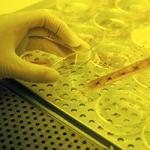
Anirban Banerjee, Ph.D.
Senior Investigator
Section on Structural and Chemical Biology
NICHD/DIR
Research Topics
The cell membrane is a uniquely complex and dynamic chemical environment. Even a simplistic binary description of an individual lipid molecule as hydrophobic tail and hydrophilic headgroup segments makes for a profoundly intricate environment considering the supramolecular ensemble of many such molecules that make up the membrane bilayer. Added to that are at least two facts that increase the chemical complexity of this environment - i) the cellular lipidome comprises of hundreds of lipid molecules whose spatiotemporal distribution is not static; ii) the membrane bilayer is juxtaposed adjacent to a rich aqueous phase with ions, small molecules and macromolecules ranging from small peptides to large proteins. Clearly, membrane proteins that have evolved to function in this milieu, have very different chemical properties and are governed by radically different constraints than soluble proteins.
We as a lab are interested in the structural and chemical biology of membrane proteins. Our goal is to obtain detailed atomic descriptions of membrane proteins, to connect their structural chemistry with their cellular function in a healthy human being and to understand how structural and functional aberrations are linked to human diseases. Towards this end, we will combine structural tools such as crystallography and cryo EM, protein and peptide chemistry and functional assays using in vitro biochemical and biophysical techniques with detergent-solubilized proteins and reconstituted proteoliposomes. We are currently pursuing studies on integral membrane enzymes that carry out post translational modifications and transporters that move small chemical entities across the membrane.
Biography
Anirban Banerjee received his B.Sc. (Honours) from Jadavpur University, India and his M.Sc. in Chemistry from the Indian Institute of Technology, Kanpur. This early training culminated in a Ph.D. in Chemical Biology in Greg Verdine's lab in the Chemistry and Chemical Biology Department at Harvard University. In his graduate thesis work, he worked on the mechanism of damaged base recognition and catalysis by DNA glycosylases, enzymes that initiate the process of base excision repair of DNA.
In his post doctoral research in Rod MacKinnon's laboratory at The Rockefeller University, Anirban focused on several aspects of the mechanism of voltage-gating in voltage-gated potassium channels and their interaction with toxins from the venoms of poisonous animals. His work resulted in the first co-crystal structure of a potassium channel in complex with a pore-blocking toxin.
Since starting his lab at the NIH, Anirban's lab has focused on structural and mechanistic studies of eukaryotic integral membrane enzymes that catalyze post translational protein lipidation. these efforts have led to the first structure of two different members of the DHHC family of enzymes that catalyze protein palmitoylation ( see Science, 2018, 359, eaao6326 ). The other major interest of the lab is in transition metal transport and homeostasis. Currently they are focusing on the mechanism of iron transport into mitochondria (See J Biol Chem. 2018 Mar 9;293(10):3819-3828 )
Amongst other honors, Anirban was the recipient of a Post Doctoral Fellowship from the Damon Runyon Cancer Research Foundation and was awarded the Nobel Laureate Signature Award for Graduate Education in Chemistry by the American Chemical Society.
Selected Publications
- Rana MS, Kumar P, Lee CJ, Verardi R, Rajashankar KR, Banerjee A. Fatty acyl recognition and transfer by an integral membrane S-acyltransferase. Science. 2018;359(6372).
- Puthenveetil R, Auger SA, Gómez-Navarro N, Rana MS, Das R, Healy LB, Suazo KF, Shi ZD, Swenson RE, Distefano MD, Banerjee A. Orthogonal Enzyme-Substrate Design Strategy for Discovery of Human Protein Palmitoyltransferase Substrates. J Am Chem Soc. 2023;145(41):22287-22292.
- Christenson ET, Isaac DT, Yoshida K, Lipo E, Kim JS, Ghirlando R, Isberg RR, Banerjee A. The iron-regulated vacuolar Legionella pneumophila MavN protein is a transition-metal transporter. Proc Natl Acad Sci U S A. 2019;116(36):17775-17785.
- Guardia CM, Tan XF, Lian T, Rana MS, Zhou W, Christenson ET, Lowry AJ, Faraldo-Gómez JD, Bonifacino JS, Jiang J, Banerjee A. Structure of Human ATG9A, the Only Transmembrane Protein of the Core Autophagy Machinery. Cell Rep. 2020;31(13):107837.
- Lee CJ, Stix R, Rana MS, Shikwana F, Murphy RE, Ghirlando R, Faraldo-Gómez JD, Banerjee A. Bivalent recognition of fatty acyl-CoA by a human integral membrane palmitoyltransferase. Proc Natl Acad Sci U S A. 2022;119(7).
Related Scientific Focus Areas





Molecular Biology and Biochemistry
View additional Principal Investigators in Molecular Biology and Biochemistry
This page was last updated on Monday, December 2, 2024